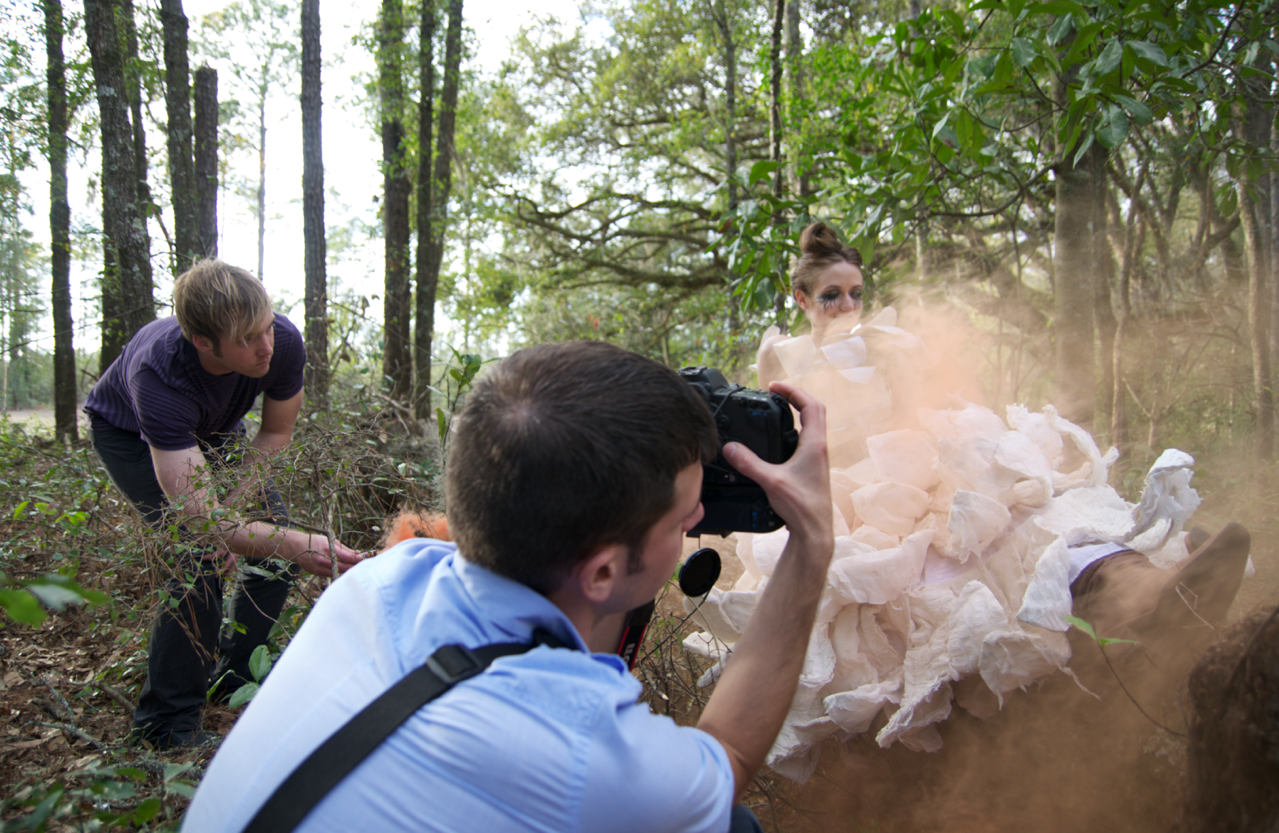EMPIRE
Savannah college of Art & Design . Urban Outfitters . August 2010
Empire is one project near and dear to my heart. In the beginning, Imaginary Forces Director, Alan Williams, and I had the notion of a fairytale and escaping the bonds of an oppressive society. We used costumes to represent conformity, vanity, pride, and impermanence. The costumes' ephemeral nature would force constant maintenance to sustain the status quo, and each costume was imbued with an animal quality that would be used in a kind of mating ritual. While Alan and I were trying to create something beautiful, Empire is a statement about how fickle the notion of beauty can be. In a world where everyone is the same, beauty is only novel when there is a sense of originality. It is that desire for individuality and autonomy that causes our heroine to seek love outside her societal sphere.
Born of a Different Cloth
The ideas behind Empire are further explained in a 45 page MFA thesis on how surrealism can be used to create memorable brand stories.
It is one of my favorite projects because of the ideas and hopes that it fosters, and because, quite frankly, we didn't know what we were doing, but we believed in it wholeheartedly. That kind of naive ambition is so inspiring about working in collaborative projects; it's a form of unspoken trust and confidence in the person by your side. Technology has changed so drastically in four years that I think we both know we could have easily pulled this off today. But in 2010, time and the pressures of life were against us. It captures my imagination to this day, and if my world were to change tomorrow, it would be the first project that I would revisit.
Empire is a statement about how fickle the notion of beauty can be
Directors: Dan Chosich, Alan Williams
Guidance: Jeffrey Boortz, Dominique Elliot, Duff Young
Costume Design: Alan Williams, George Chosich
Seamstress: George Chosich, Liz Chosich, Kerri Williams, Alan Williams
Camera Op: Dan Chosich
Compositing: Alan Williams, Dan Chosich
3D Modeling: Dan Chosich
Practical Modeling: George Chosich
Concept Art: George Chosich
Posters: Heather-Lynn Acquino
Editing: Dan Chosich
Empire derived from some of the imagery found in the children's book Henry In Love by Peter McCarty.
The story
In a world where ornate attire is an accepted generational decree, a boy from an ancient lineage of outcasts is forever banned from the elitist clothing of his land. In this Empire, the vain citizens' fashion begets function: movements are restrained, and interactions are an afterthought.
Born of a different cloth, the boy traverses obstacles on his way to school. He lacks the elaborate attire, the artifice of superiority, and all the restricted movement of the status quo. However, today was different from all the rest. On this day, sitting in the back of the classroom, was the Queen of this Empire. The boy became instantly enamored; her beauty dissolved the walls of the confining room.
The following day, a search is on for the Queen's suitor, and only the most elaborate attire in the land is to be considered. Our hero watches but is forbidden to partake in the courtship. Event participants line up, preparing to offer themselves to the Queen. Wings flare, costumes are primped and sewn. Suitors line up to impress. Determined to win the heart of his Queen, the boy works tirelessly through the night, binding discarded scraps of paper and sticks. The Queen startles the boy; their eyes meet, and he is unsure of her reaction. The Queen pushes off his makeshift costume.
Alarms blare, houses pop open, and come to life. The Empire is awakened by the Queen's absence. Our hero and the Queen look at one another. The Queen knows our hero's life would be destined for dismay, so she takes his hand and leads him far beyond the permitted towers to a wild place. As they run, the restraints of her costume tear, and an unfamiliar feeling of freedom washes over her face. They reach the bounds of their surroundings, and light emits out of a crack in the side of a mountain that the boy can fit through. However, the Queen cannot fit because her costume prevents her. She looks back at the Empire, which is far in the distance, and they lock eyes. Ben puts out his hand. The end.
Themes
Forbidden Love
Freedom from Convention
Transformation from Outcast to Rebel
Deliverance
Pursuit of Acceptance
A Daring Enterprise
Rivalry
Rigid vs. Loose
Conformism vs. Individualism
Costume Creation
Of Wings & Dresses
Empire is built around a fantastical fable of forbidden love. An outcast hero and a discontented Queen rebel against the rigid conventions of their land in order to be together. The oppressive vanity of convention is represented through delicate paper couture dresses that hamper movement. Conversely, our hero's individualism is represented through loose-fitting casual clothing. Exhausted from the weight of both her enveloping costume and the expectations of the Empire, the Queen develops an attraction for our free-spirited hero that will lead them on a journey in opposition to the status quo.
The campaign was developed as a unique episodic narrative that engages the viewer in a timeless vision of love's ability to transcend entrenched values. The environment is a reflection of the characters and the tenets of Surrealism by being constructed on unstable foundations and utilizing skewed dimensionality. The alternate reality defined in Empire defies causal expectation but remains consistent throughout the entire campaign.
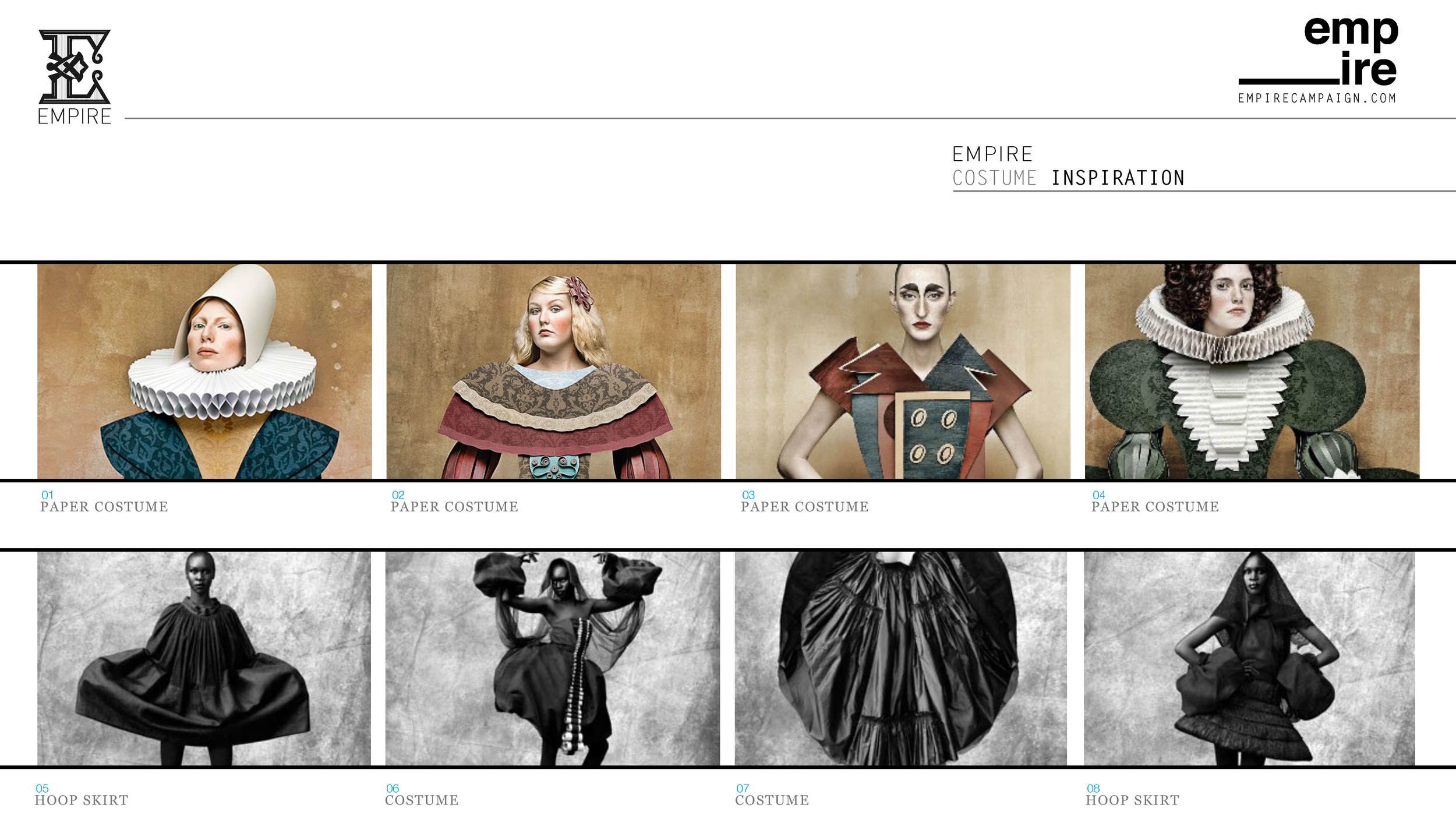
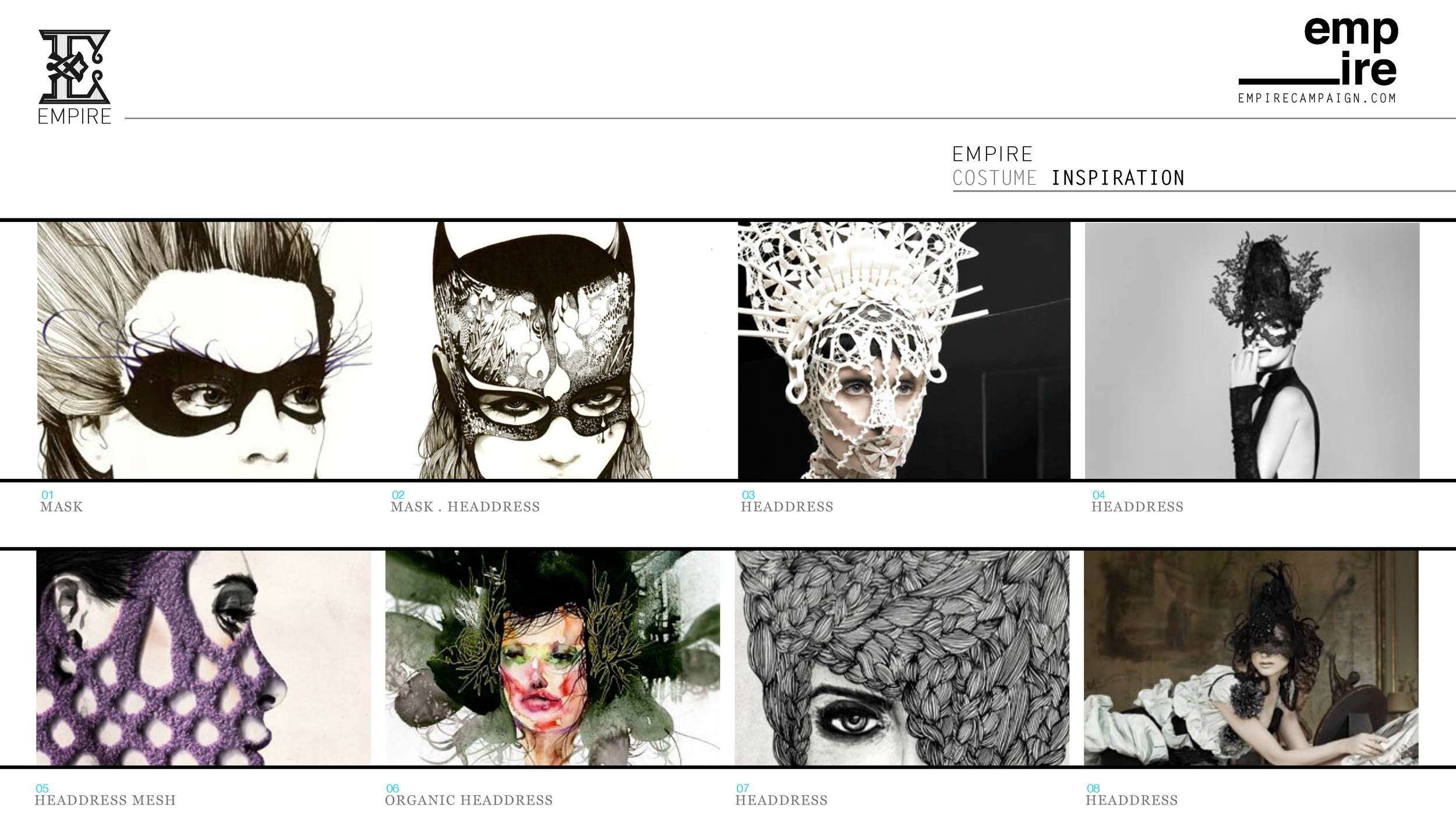
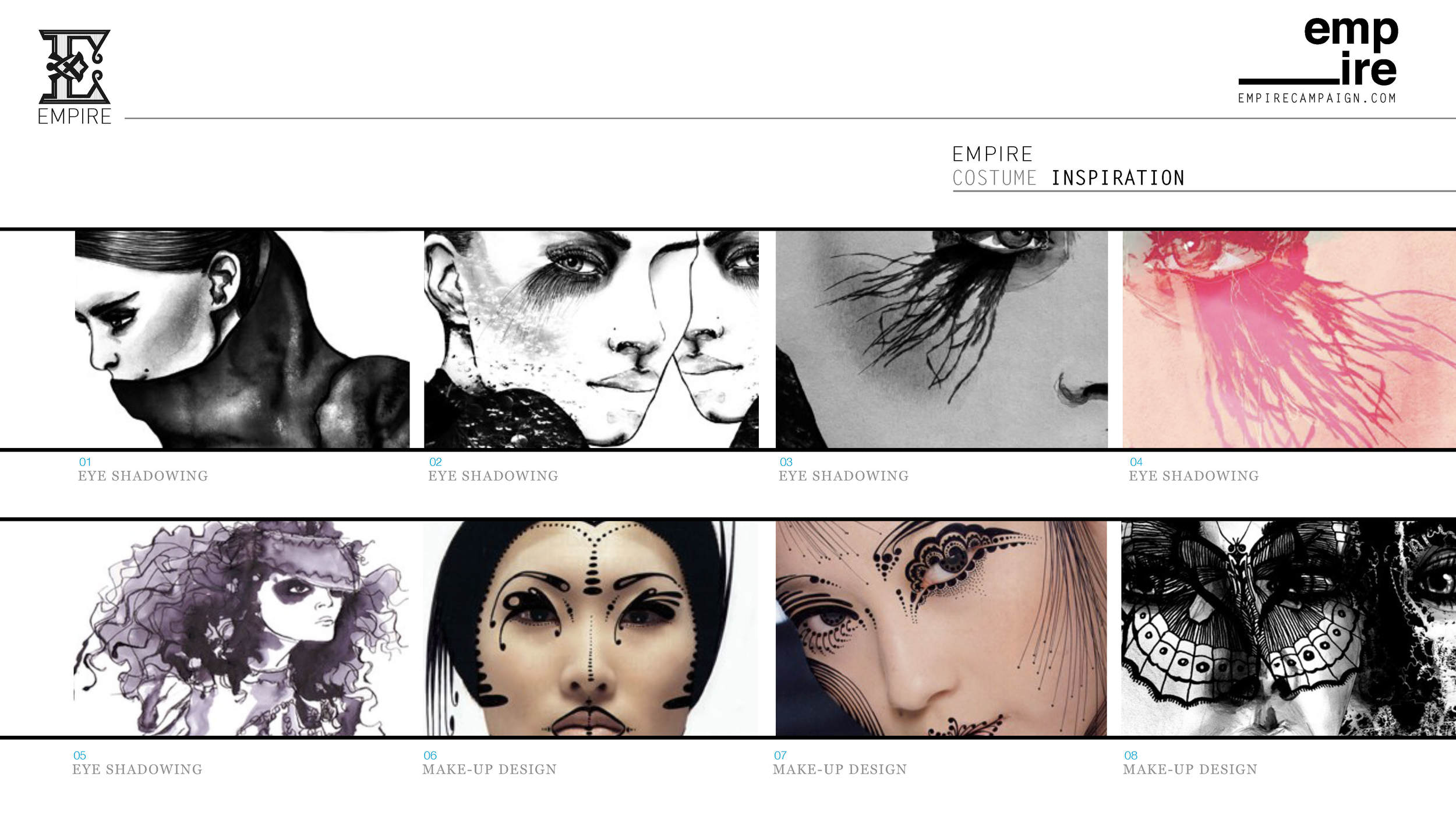


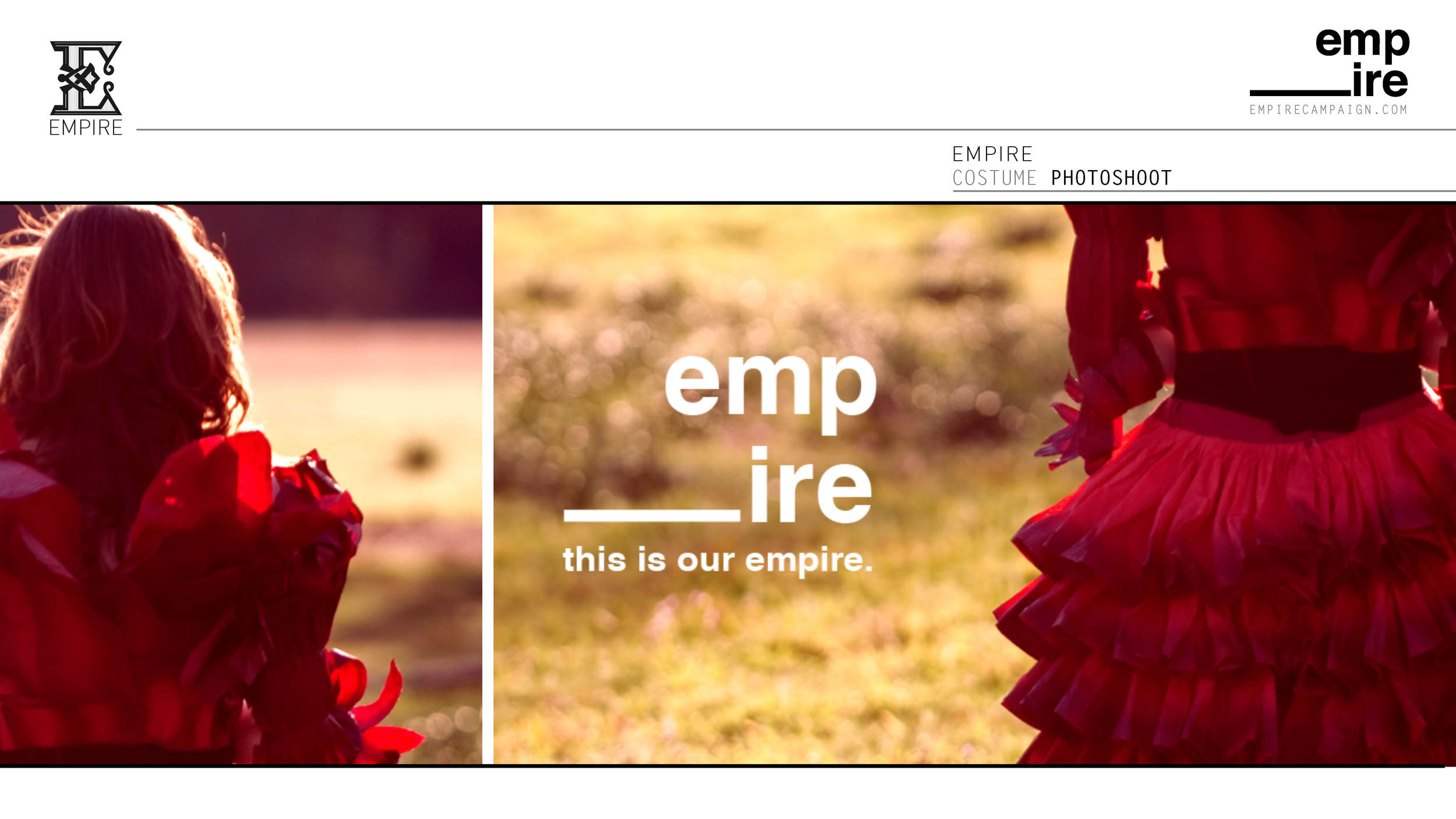
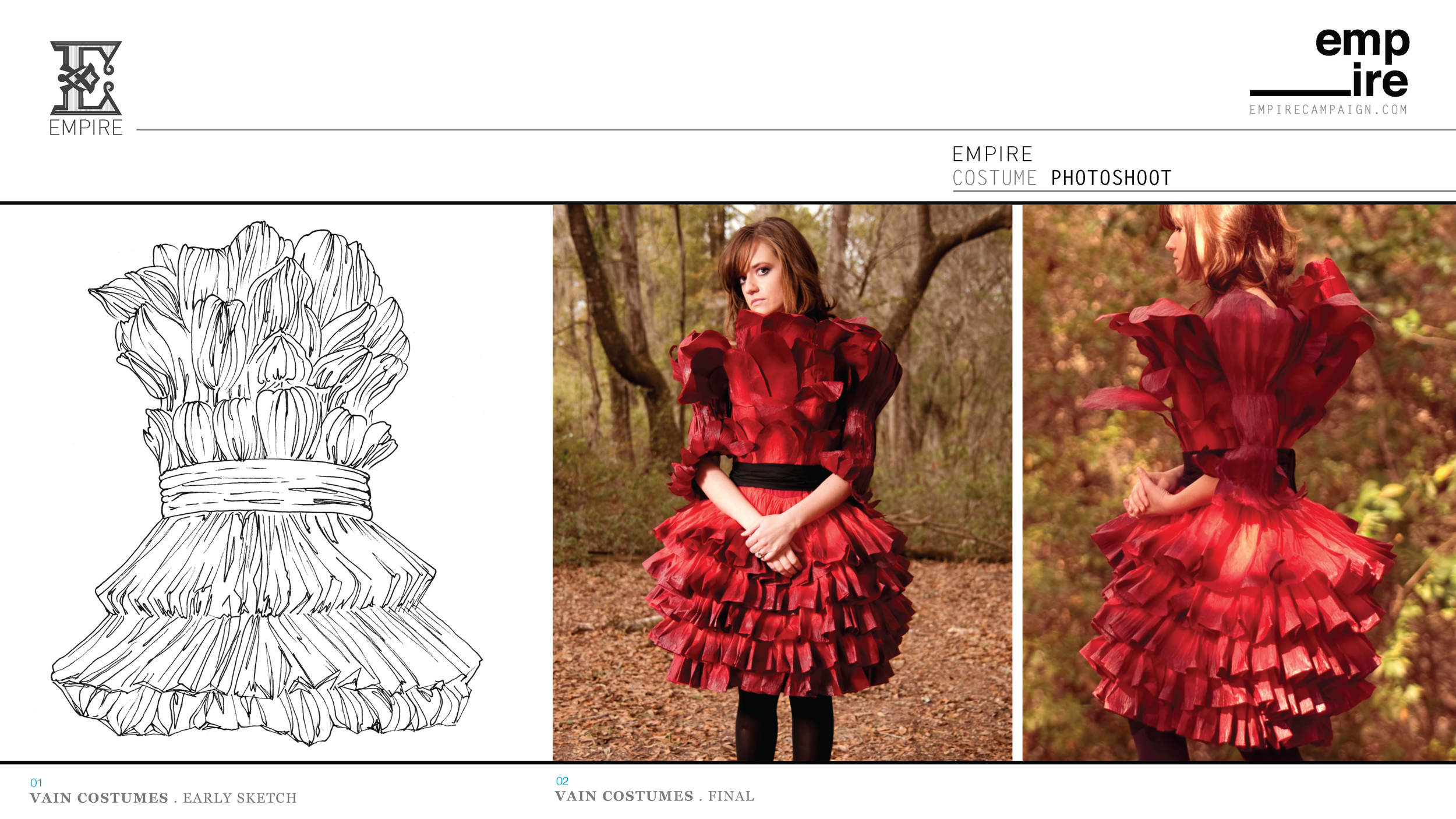
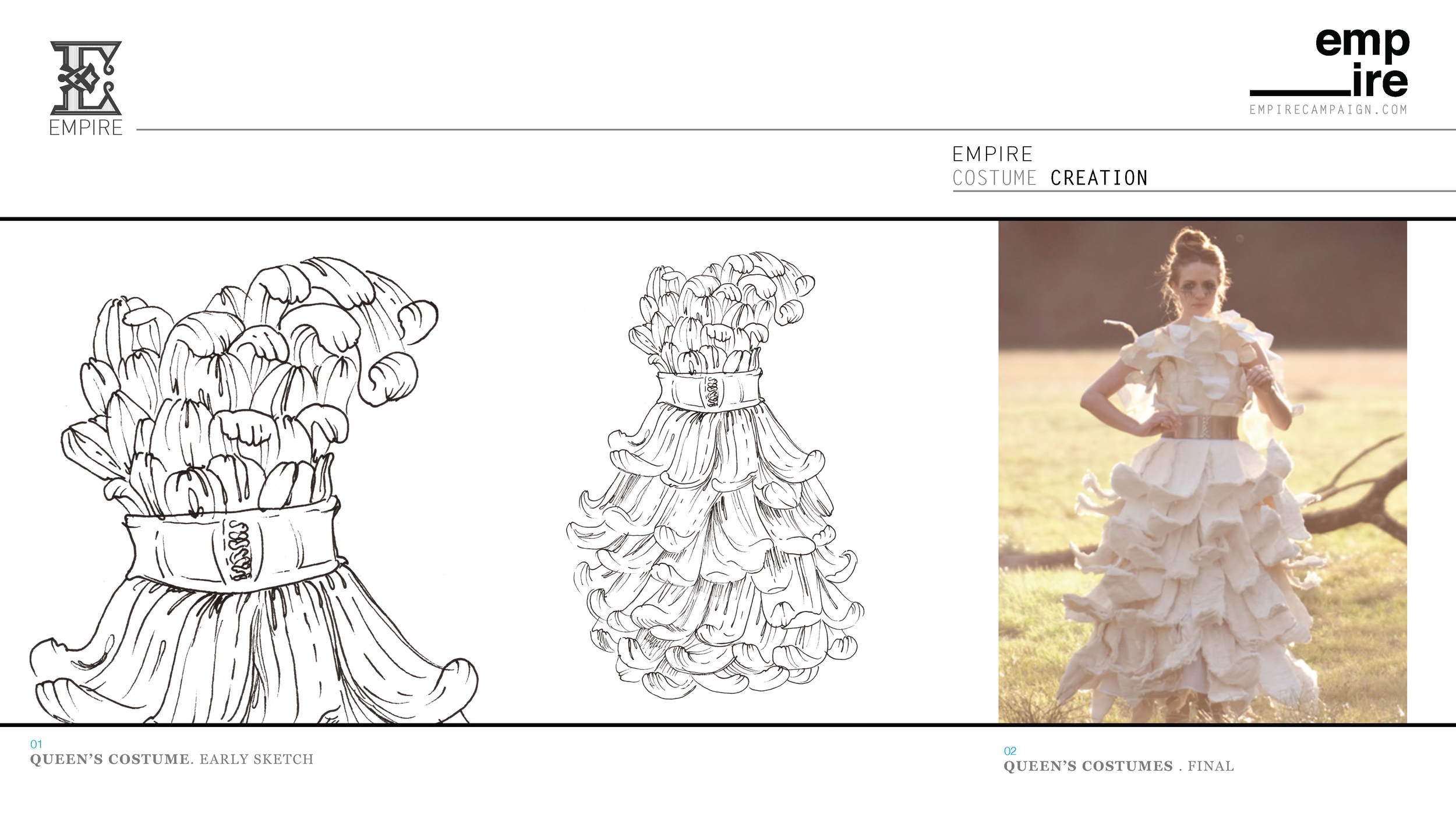
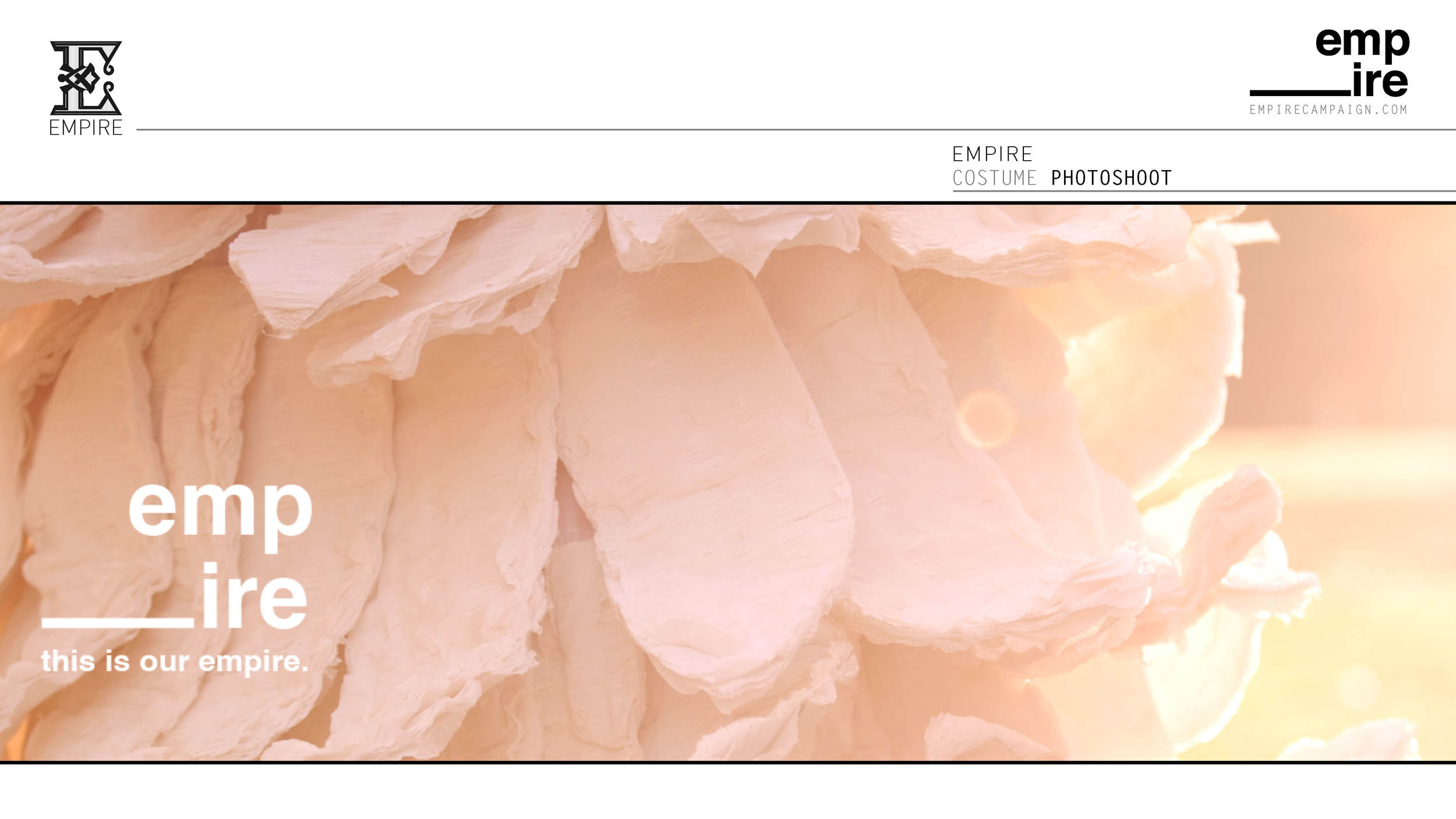
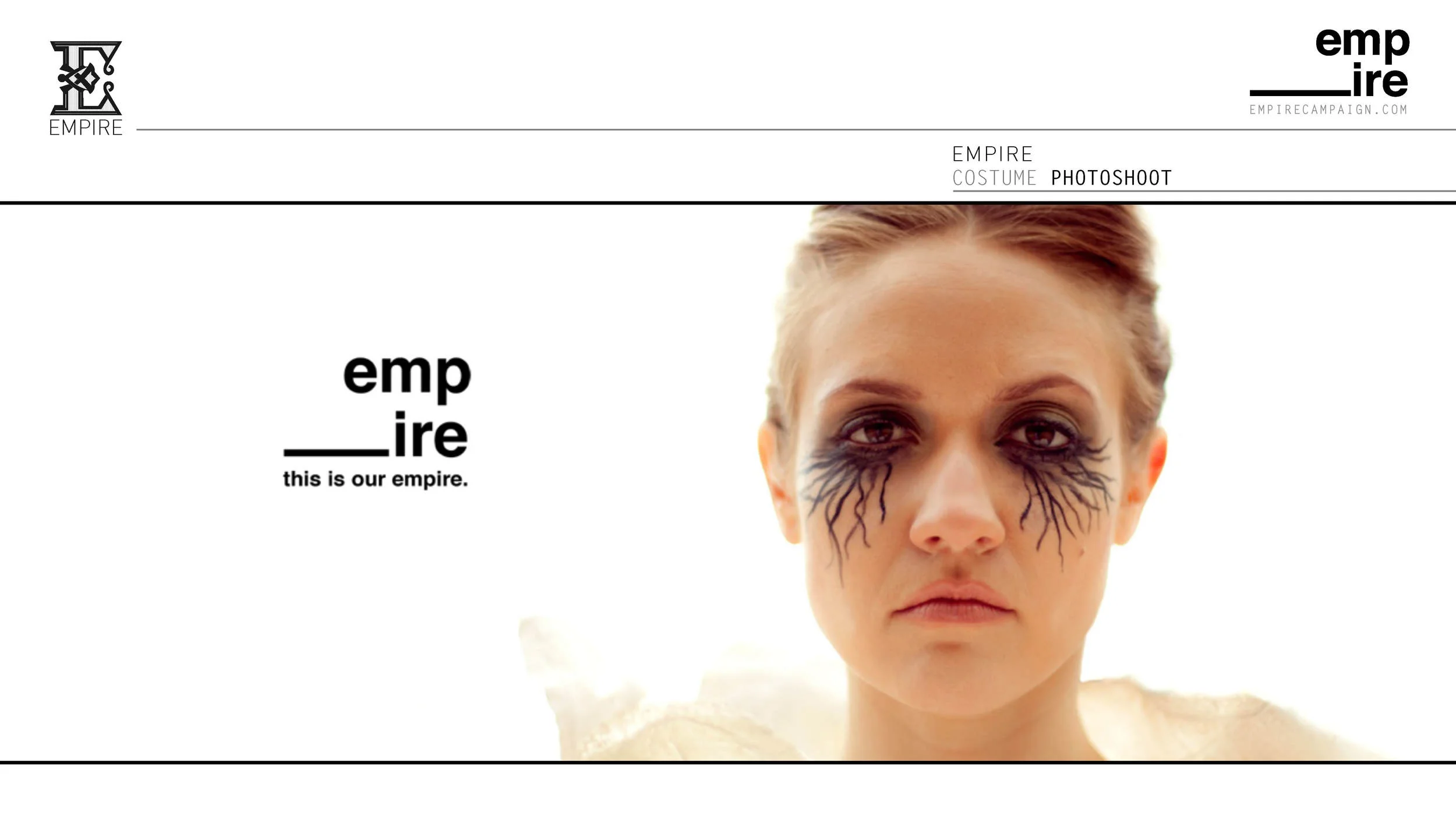
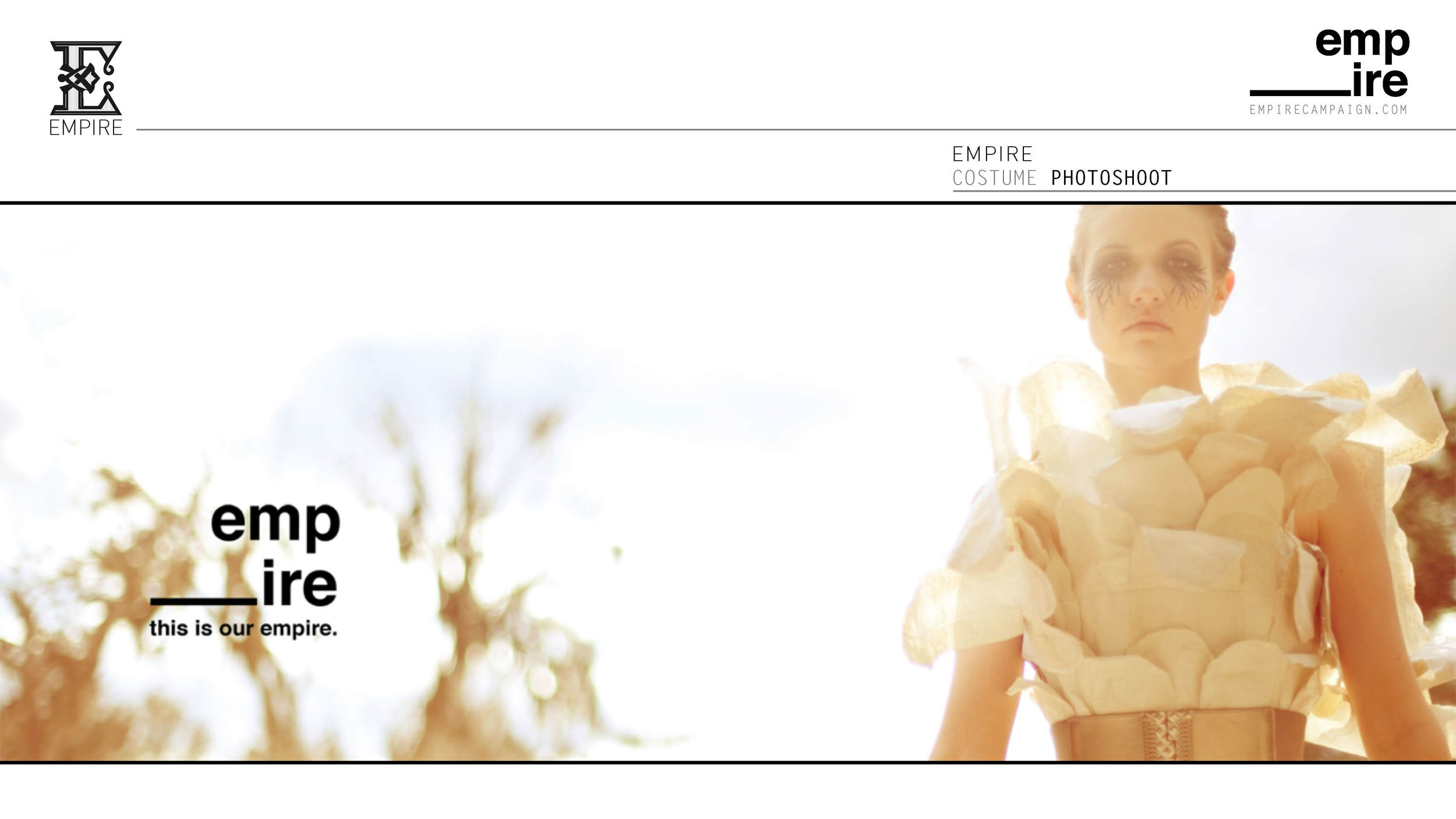
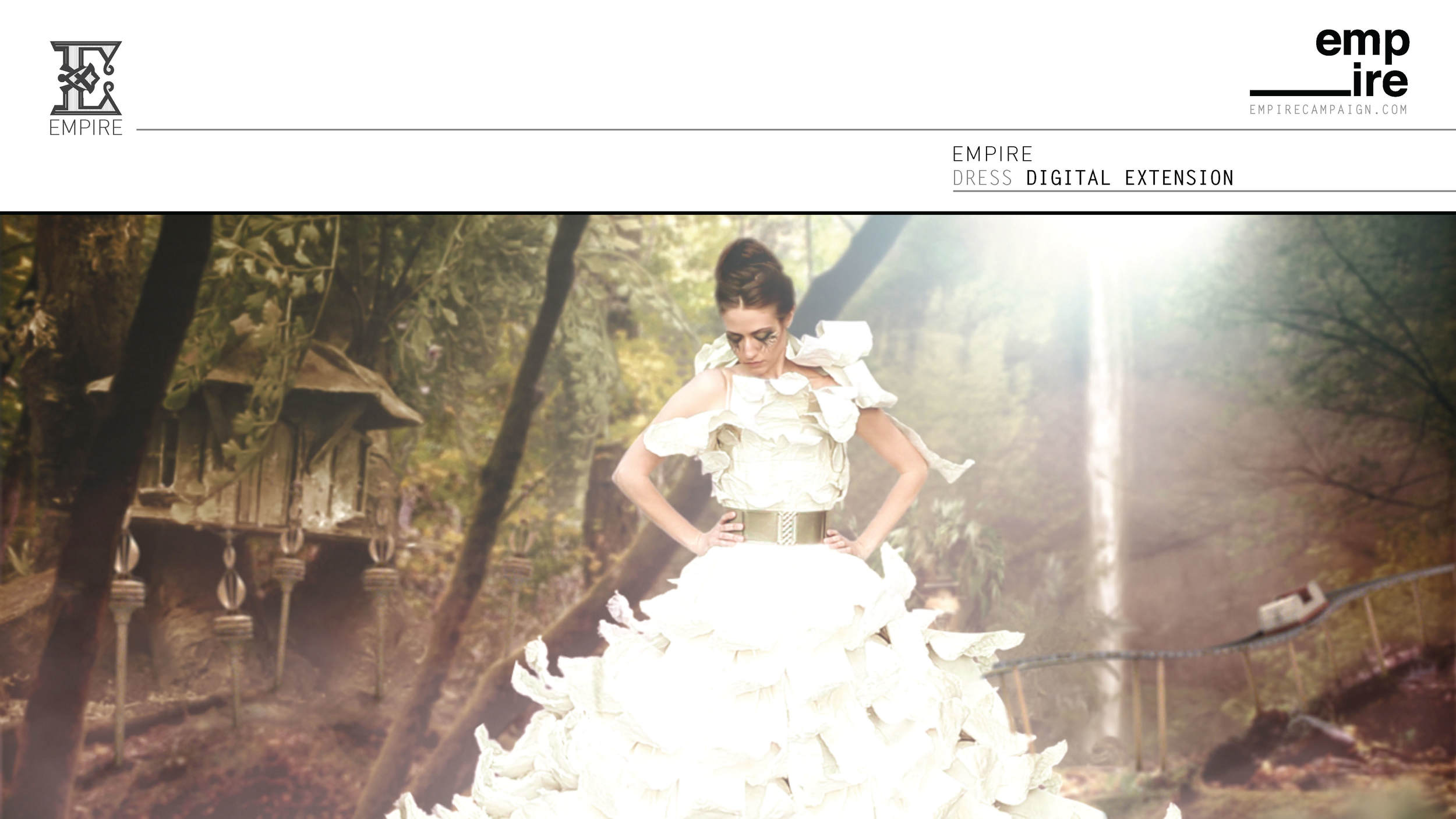
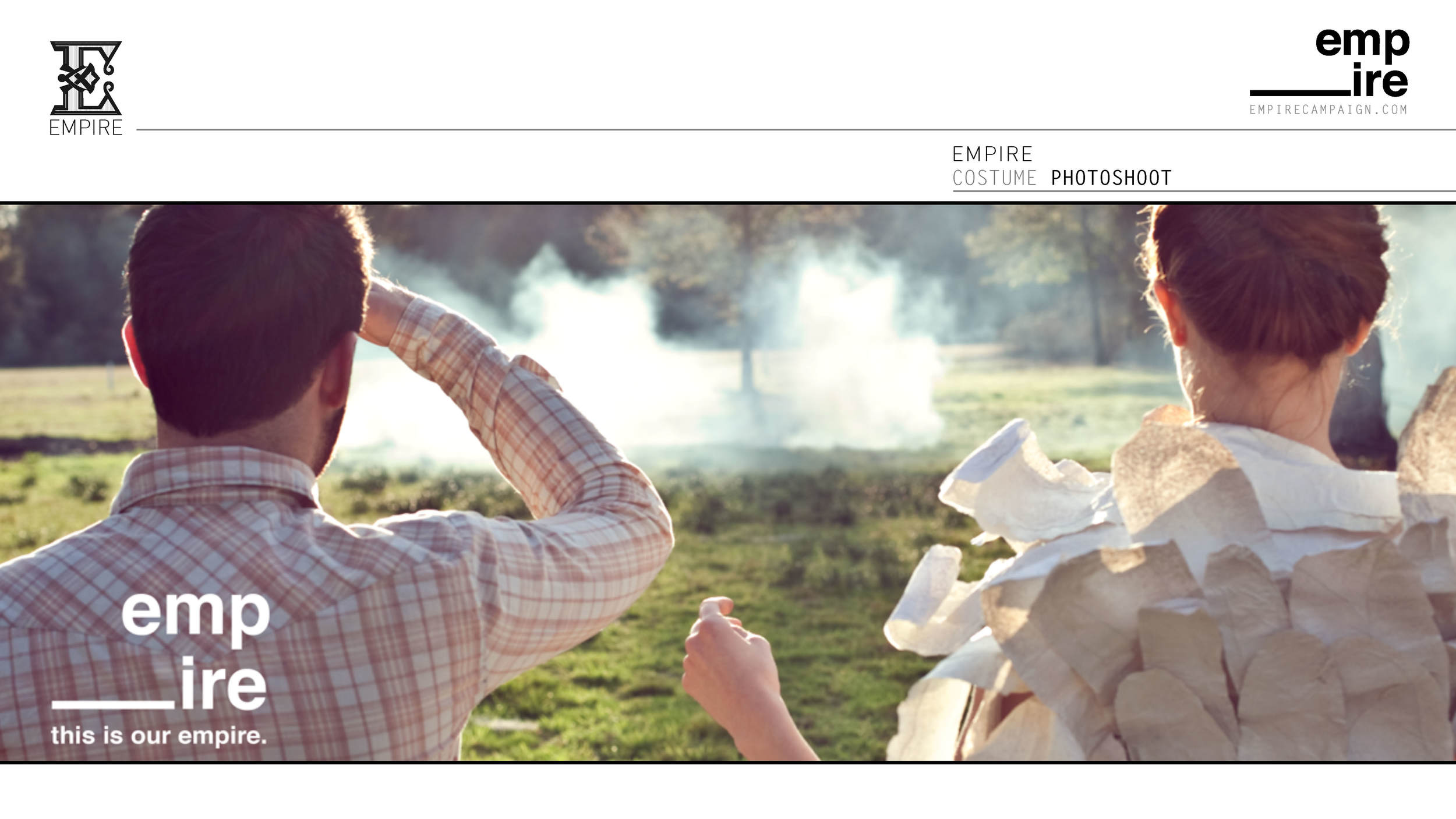
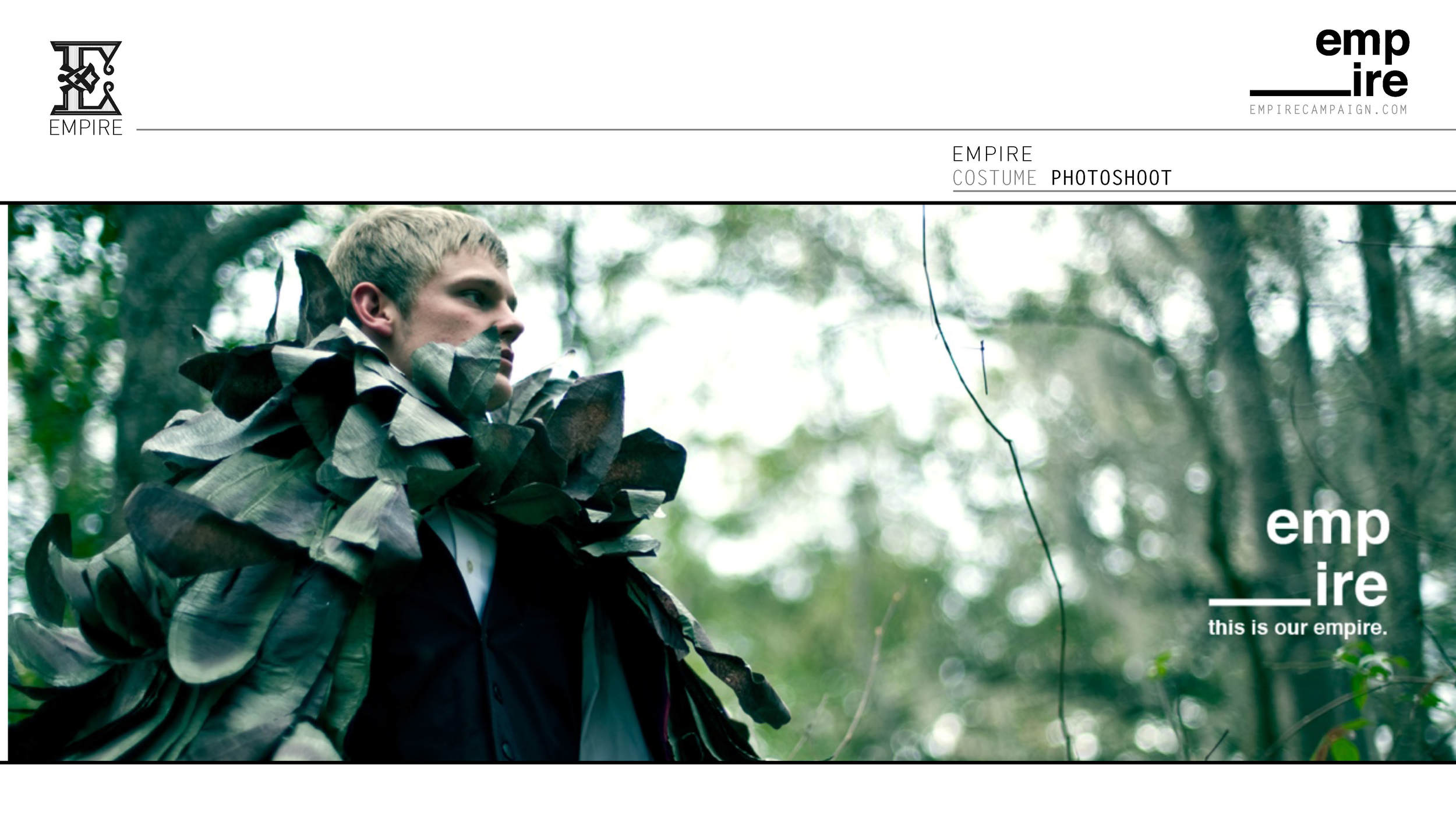
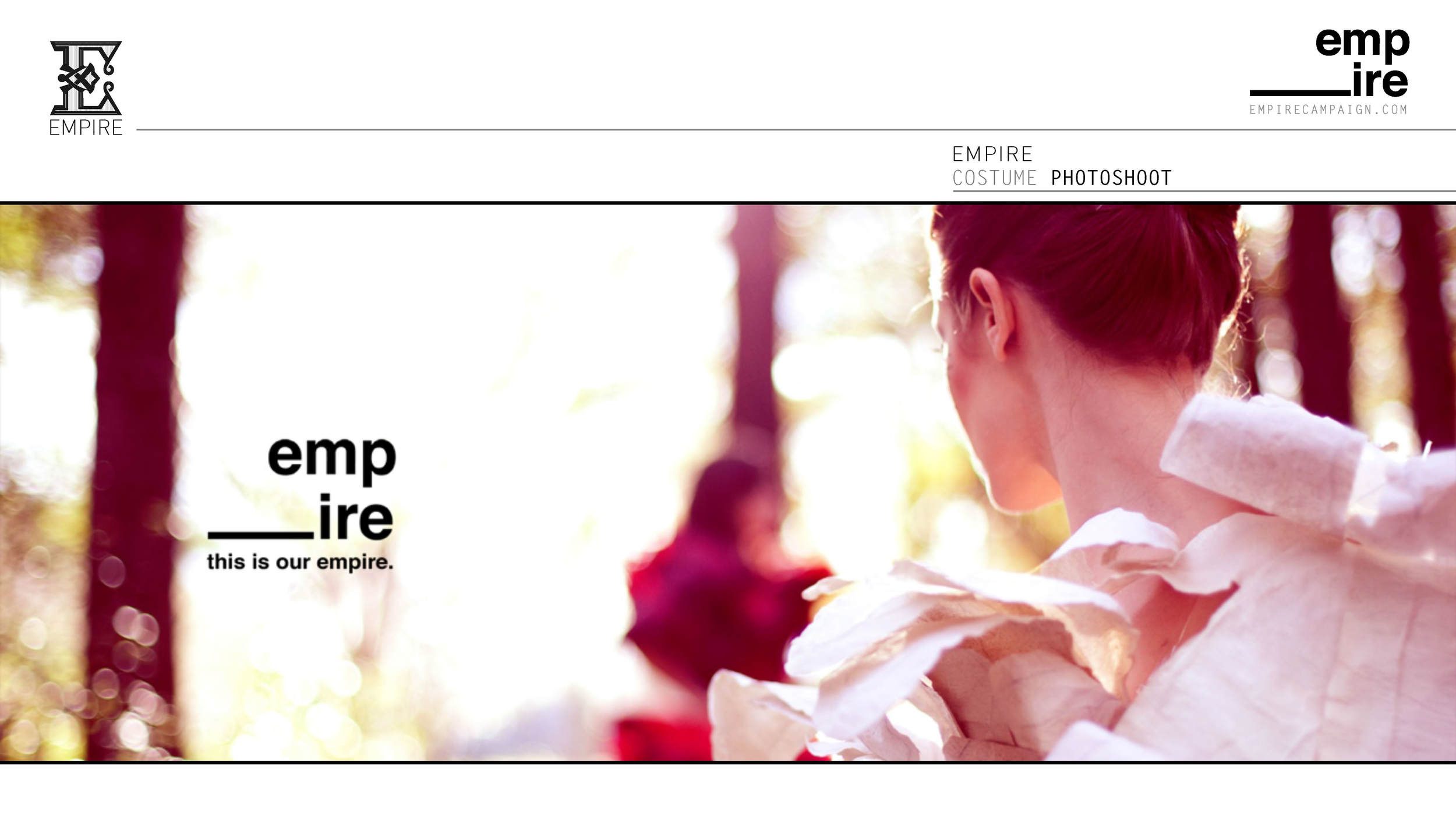
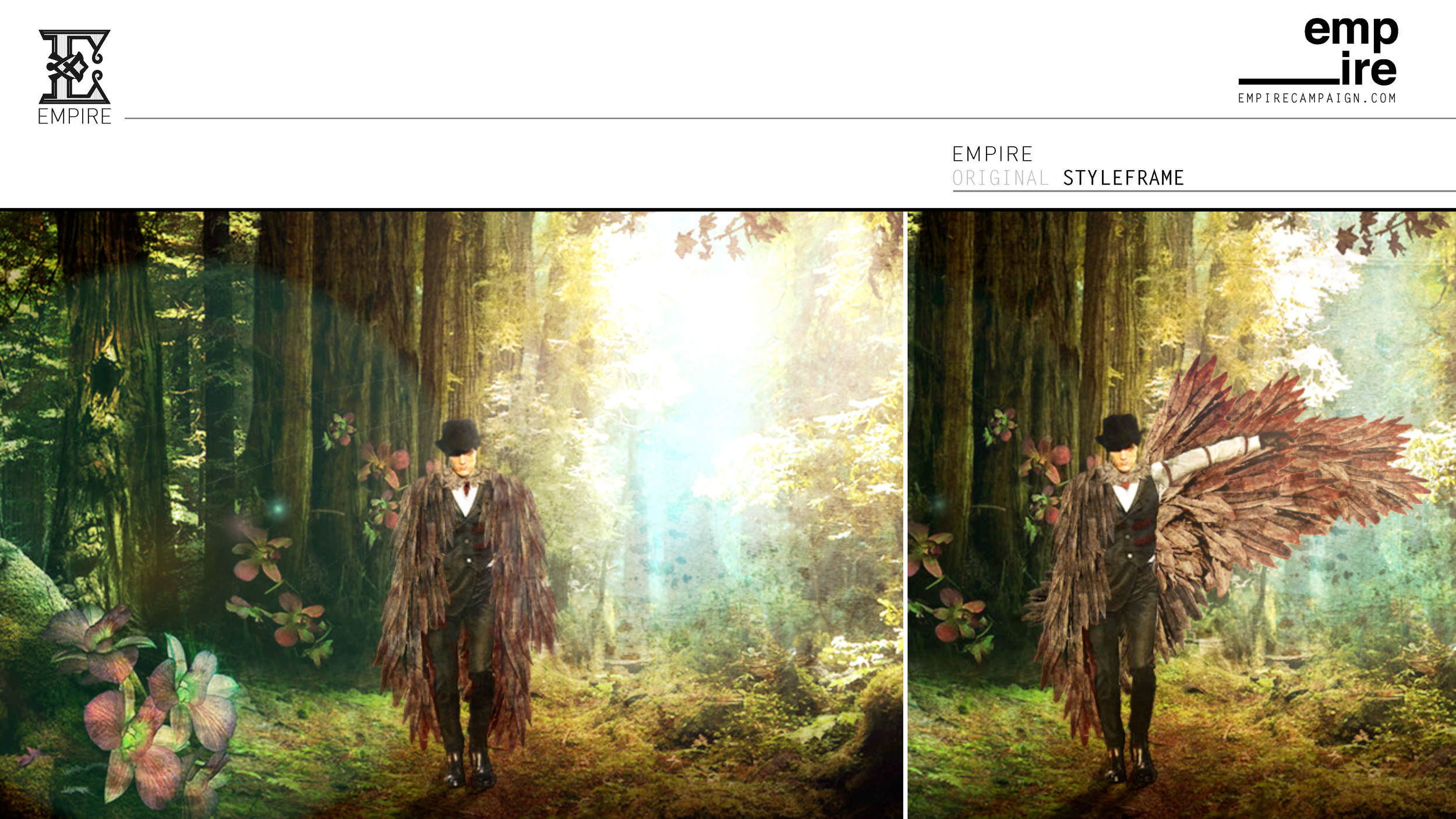

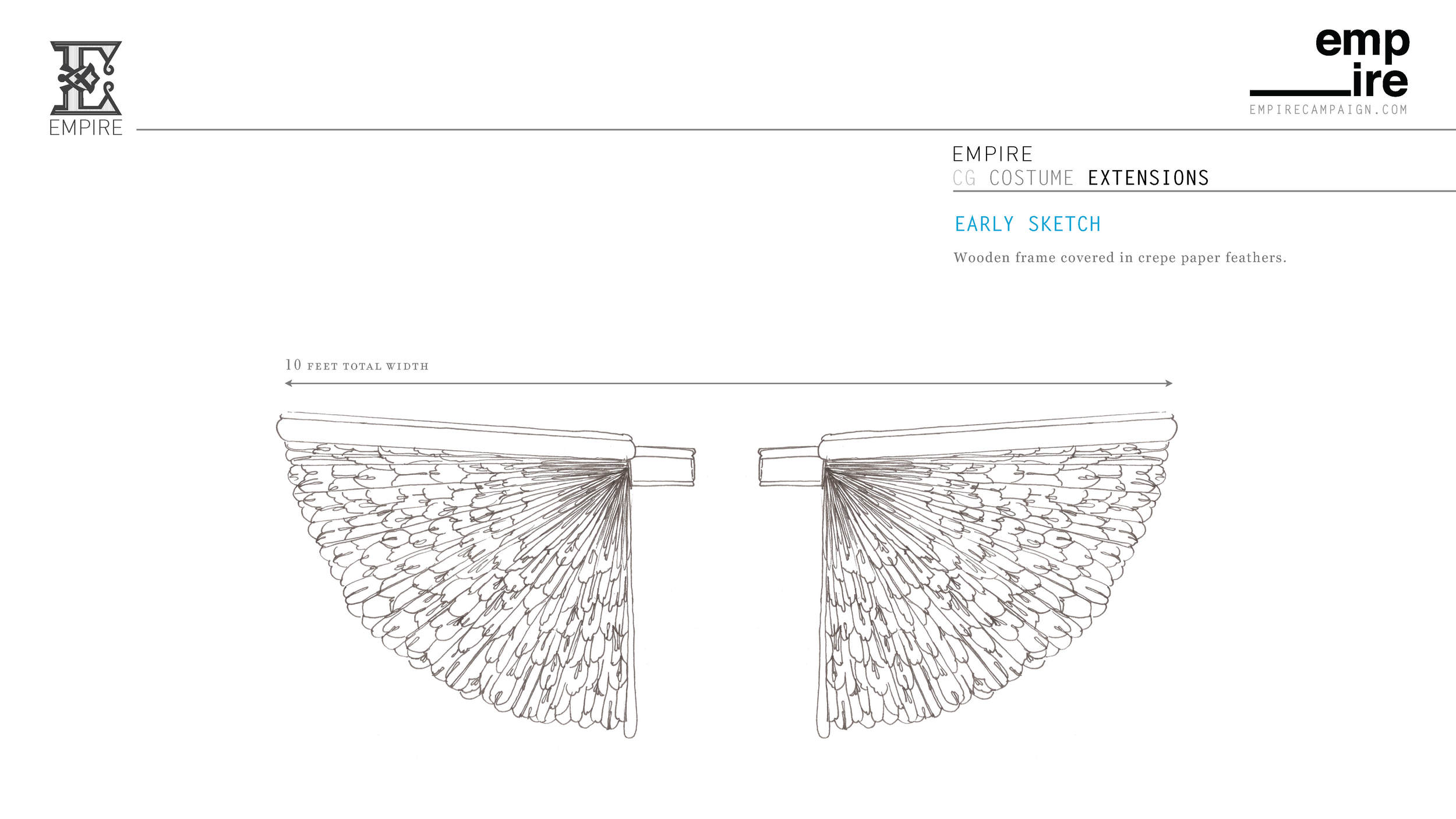

“
The Queen:
It is indeterminate if she will even be hinted at until the end of the first 30-second spot. Yet, she is the most ornate character. Her beauty explodes. She is liberated by the man at the end. Huge hoop skirt that has to be removed to fit through the hole.
Empire Costuming:
Victorian costumes might visually contrast a forest setting quite well. Victorian costumes are also the polar opposite of denim comfort. The question then becomes why do they have elaborate clothing and then live in tree houses?
We could also go the Miss Havisham route and have them wearing incredibly old Victorian clothing that is somewhat tattered. The tattered Victorian clothes would visually suggest that these are the only clothes they wear and that their playful nature has worn them out.
Some form of arm band or color blocks on their hands also denote status?
”
A rebellion against the empire of self indulgent fashion and class
Early Queen Costume
The Queen's dress was an important element of the Empire. She was meant to exude a raw kind of beauty. It was Alan's role to digitally add extensions to the dress. The context of the time is crucial to remember; this was right after Spike Jonze had released "Where the Wild Things Are." "Where the Wild Things Are" used costumes on actors instead of 3D animation, but then digitally extended expressions onto the faces of the costumes to bring the characters to life. Alan wanted to create a larger-than-life dress, an unwieldy piece of clothing that would require servants to wear and maintain. Thus, over a short period of time, the dress transformed into something resembling a blossoming flower or a swan. Remarkably delicate, it was also incredibly durable. All of the dresses were made using crepe paper, wire, base elastics, and glue. They were an engineering feat and encumbered the actors, which serendipitously aided their performance.
Final Queen Costume
Practical Models
Starting in early January 2010, work began on the visual campaign. Before storyboarding, one of the first steps was to map out and formulate how characters could move and interact within the environment. A large tree would act as the epicenter for the Empire and also as a point of reference for each shot. Anywhere the viewer stands inside the Empire, the tree orients the viewer as to their location. The tree is an important element because it provides visual cues as to how the inhabitants of this Empire divide social classes and how they respect the environment in which they reside. The tree itself is broken, and the limbs are shorn off, implying a decadent society. The overgrowth and supremely large nature of the tree hark back to the oversized fruits and vegetables of surrealist artist Giorgio De Chirico. The tree itself is built upon a harsh landscape of stone. The weathered landscape and the restrictive nature of the clothing require an automated system of transportation. The vain characters in the Empire must ride on rail systems to gain access to the schoolhouse atop the tree.
The first thing constructed was the tree itself. It had a 4x4-inch wood armature that was cut at a 20-degree angle to cast the trunk of the tree in a position simulating movement. Two-inch high-density polystyrene foam was glued to the armature with expanding polyurethane foam. The basic shape was made using a serrated knife and a long-bladed reciprocating saw. Using a grinder and a 5-inch cutting disk made the bark detail.
Once the tree was shaped, it was coated in an acrylic base coat to protect the foam from damage from any spray paint used from aerosol cans. The spray paint would etch the foam if it were not first coated in an acrylic paint. In order to film the model in the round, it was determined to have the model table pivot around a central axis. This was accomplished by using wheel bearings and roller-ball castors that provided near effortless smooth movement for filming all elements of the model.
A system of electrical brushes on copper-ringed commutators provided the model with electrical current without wire entanglement when the need arose for lighting and train movement while filming.
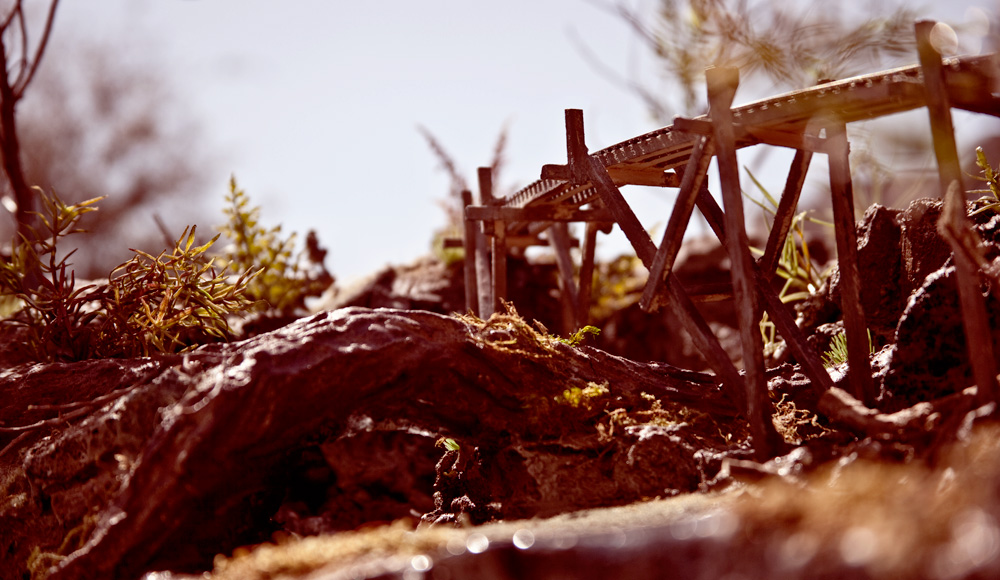
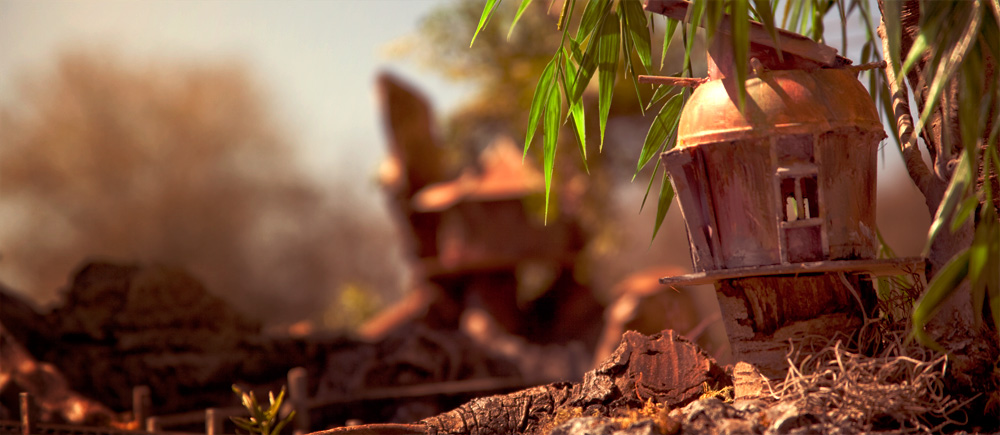


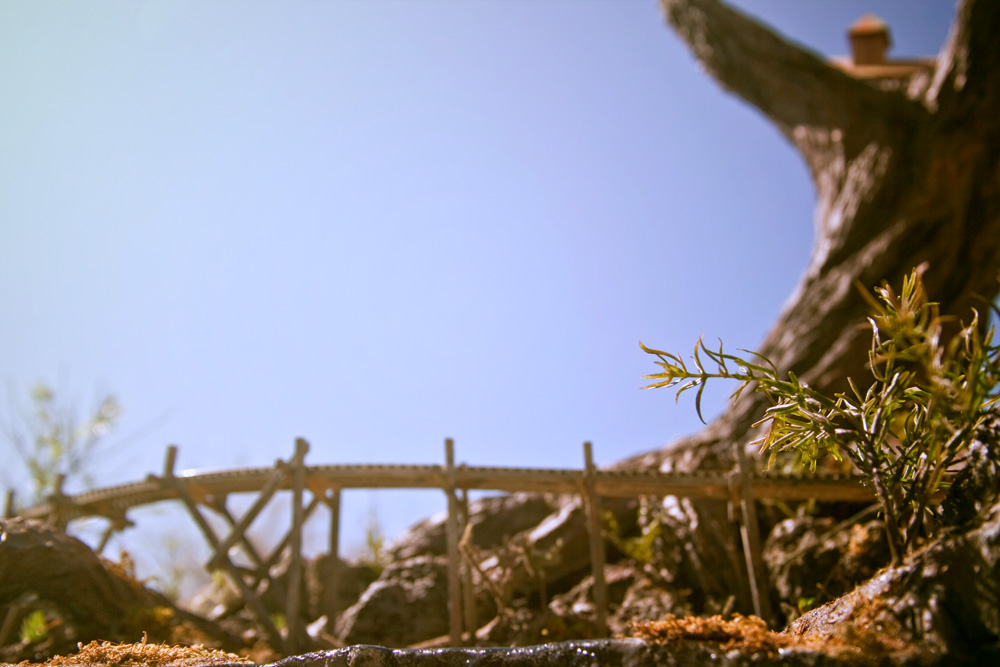
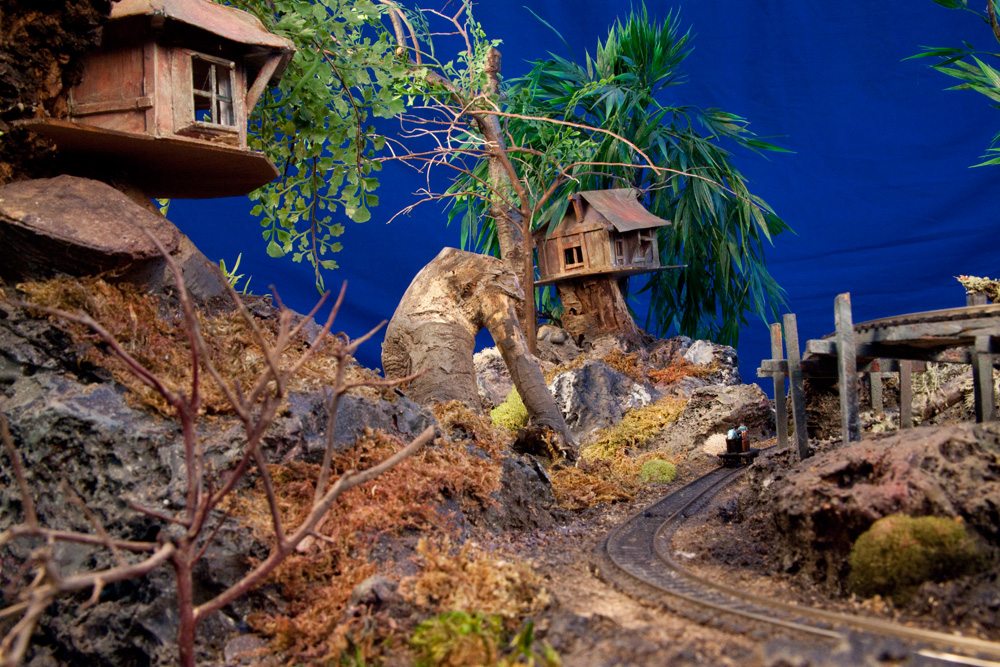
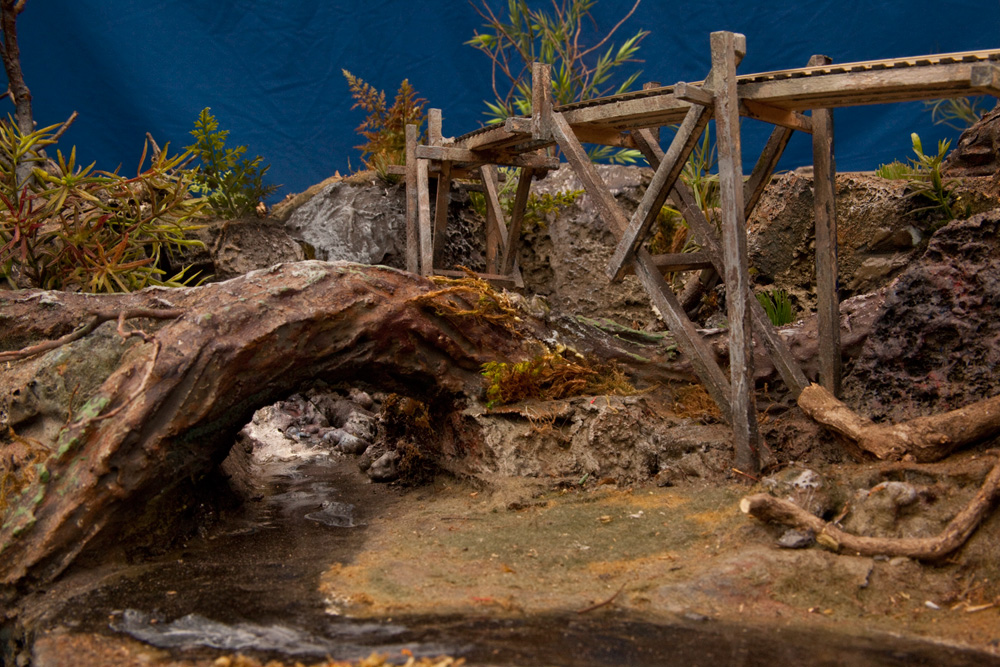
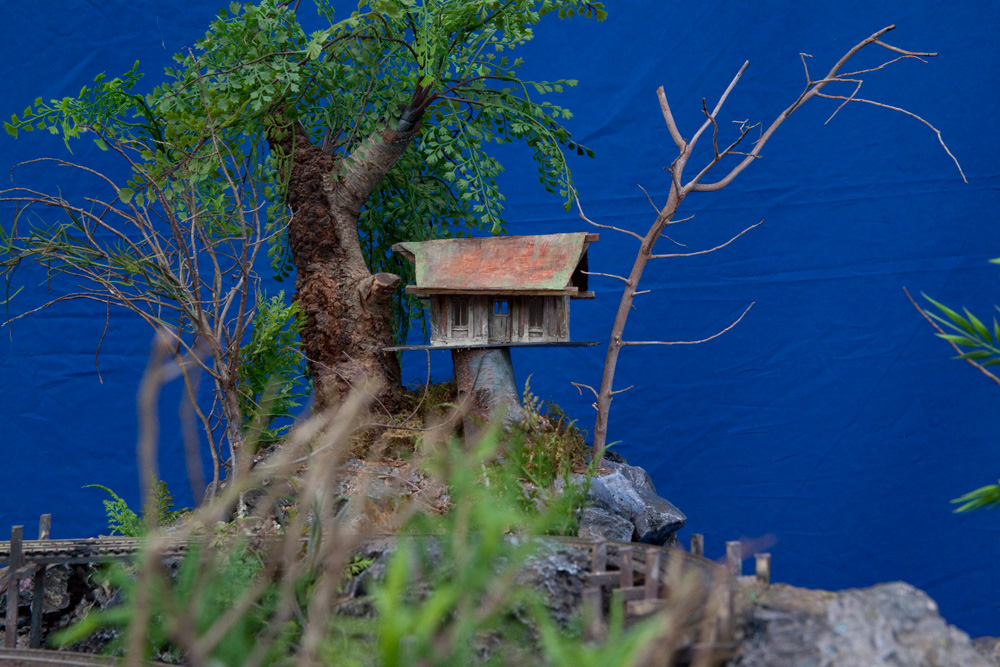
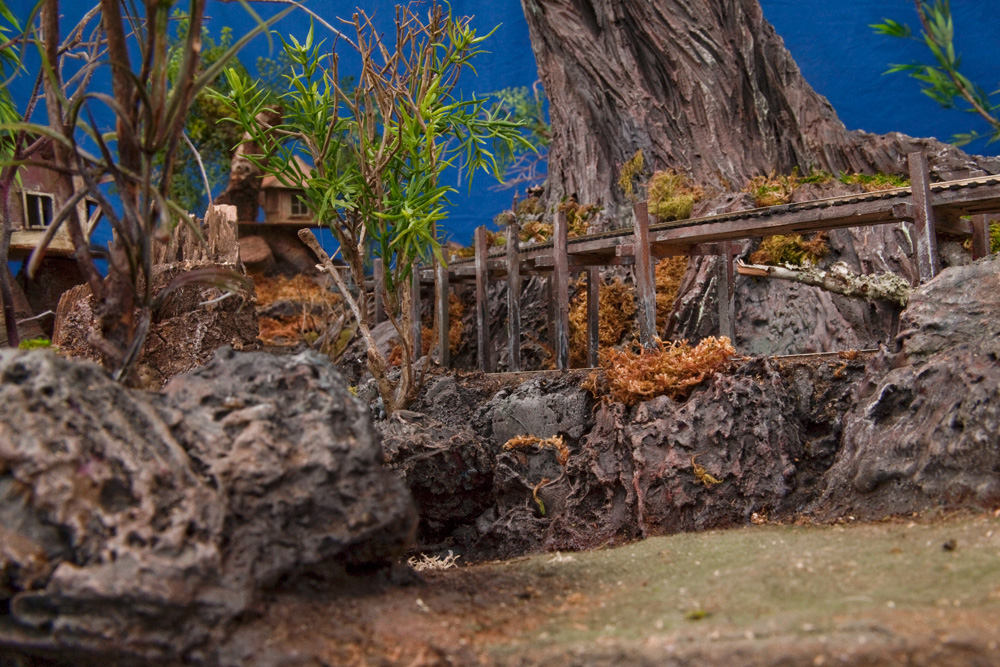
Experimentation for rock formations was complicated. After using real rock impressions in modeling clay and casting plaster in the impressions, it was determined that the process was not only time-consuming and costly, but it also lacked the desired effect. An accidental spill of lacquer thinner on a piece of polystyrene provided a result that produced the most dramatic effect of rock structure for the model. When the etching of the polystyrene subsided, an acrylic paint was applied to provide the landscape currently seen on the model.
Real mosses, miniature ferns, and lichens were glued to various areas to provide a juxtaposition of hard and soft surfaces, lending visual interest to the environment. Other surfaces were covered with adhesive glue and either sprinkled with colored flocking or sawdust, which was later spray-painted to achieve a rugged appearance. A clear epoxy resin was spread over a black acrylic painted surface to simulate water. The model was made in four segments that could be removed from the main frame of the unit for transport. A rolling base was constructed to provide mobility to the model, as it would need to be moved to natural light or a location where a blue screen could be erected for filming.
The tree houses were made from split popsicle sticks, 1/16-inch luan mahogany, and cereal box cardboard covered with acrylic paint. The entire model's surface was built from polystyrene foam. The interior of the tree houses has LED lights that can be lit from the same location as the track regulator. The overall presentation of the Empire model was meant to mimic an excavation of a plot of land from Earth and placed on display for observation in a surreal setting.













